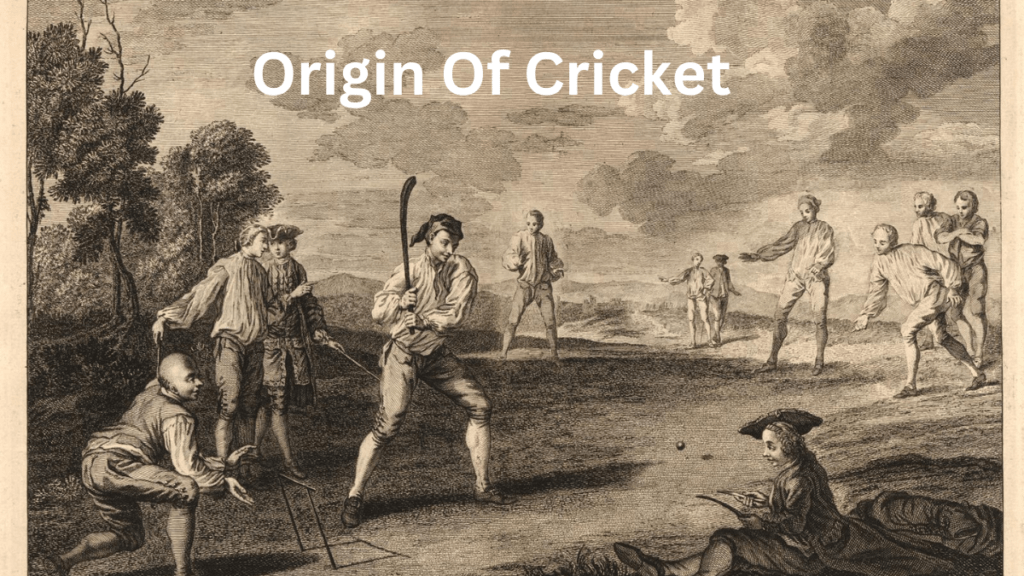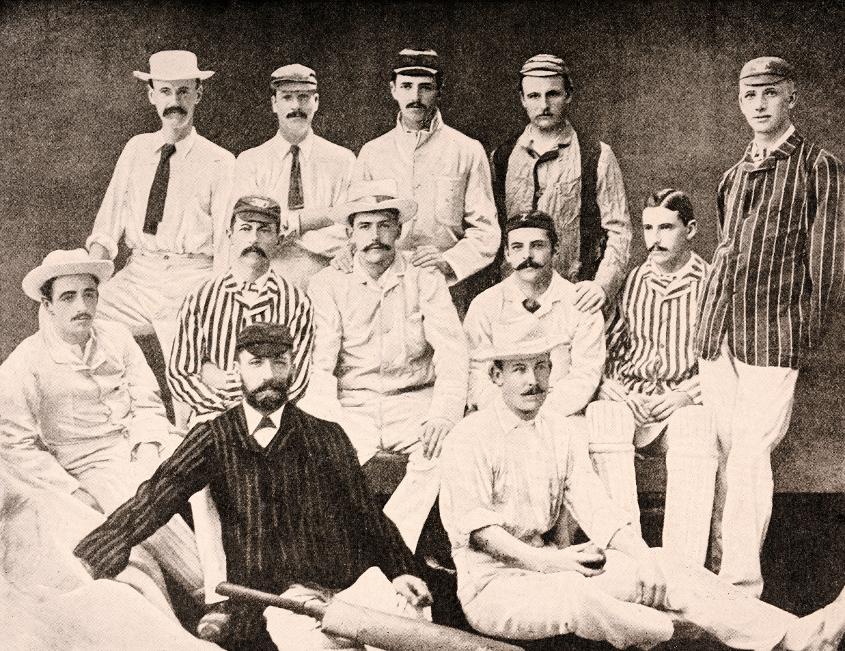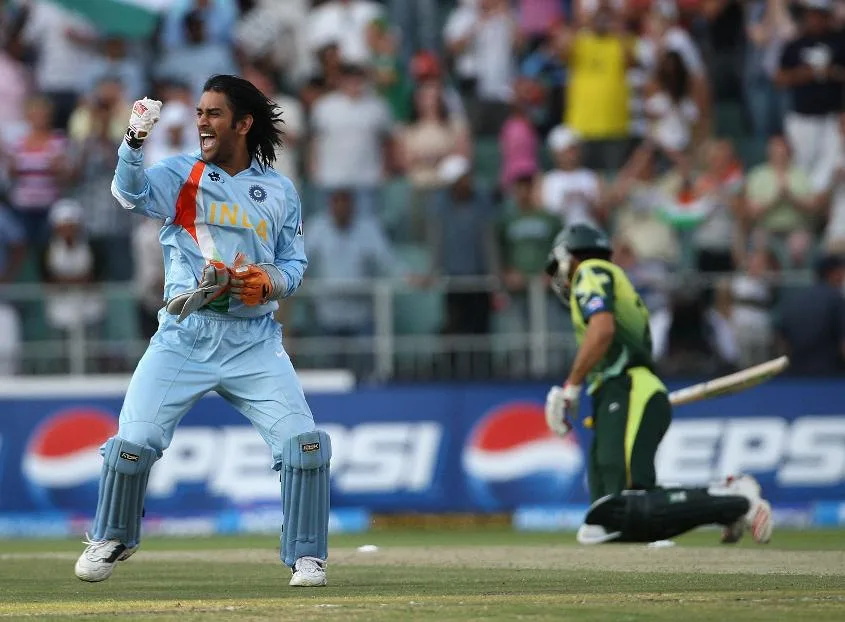History of cricket is dating back to the late 16th century. It originated in south-east England, became a national sport in the 18th century, and expanded globally in the 19th and 20th centuries. International matches have been played since the nineteenth century, with formal Test cricket matches dating back to 1877. After association football (soccer), cricket is the world’s second most popular spectator sport.
Cricket is administered internationally by the International Cricket Council (ICC), which includes over a hundred countries and territories as members, however only twelve now play Test cricket.
The “Laws of Cricket” define the game’s laws. The game has several formats, ranging from one-day cricket to Test matches that can last up to five days.
Table of Contents
Origin Of Cricket

Cricket was invented by children living in the Weald, a region of dense woodlands and clearings straddling Kent and Sussex in south-east England. The first written reference is from the late 16th century.
There have been numerous theories concerning the game’s beginnings, including the possibility that it was developed in France or Flanders. The first of these theoretical references is dated 1300, and it refers to the future King Edward II participating in “creag and other games” in both Westminster and Newenden. It has been proposed that “creag” is an Old English term for cricket, but experts believe it is an early spelling of “craic,” which means “fun and games in general.”
Cricket is thought to have endured as a children’s game for many generations before it was largely adopted by adults around the beginning of the 17th century. Cricket may have evolved from bowls, assuming bowls is the oldest sport, by the intervention of a batsman attempting to prevent the ball from reaching its goal by hitting it away. The ball may have been a matted lump of sheep’s wool (or possibly a stone or a small chunk of wood) as the initial implement for playing on sheep-grazed ground or in clearings; a stick, crook, or other farm tool as the bat; and a stool, tree stump, or gate (e.g., a wicket gate) as the wicket.
The first specific reference of Cricket
A court case in England in 1597 (Old Style – 1598 New Style) involving an ownership dispute over a tract of common land in Guildford, Surrey, references the game of creckett. Coroner John Derrick, 59, said that he and his schoolmates had played creckett on the location fifty years before while they were students at the Free School. Derrick’s description establishes beyond a shadow of a doubt that the game was played in Surrey around 1550, and it is the first broadly acknowledged reference to the game.
Cricket was first mentioned as an adult activity in 1611, when two men in Sussex were prosecuted for playing cricket instead of going to church on Sunday. A dictionary categorized cricket as a boys’ game the same year, implying that adult participation was a new phenomenon.
The origin of the term “cricket”
The term “cricket” may have derived from the Middle Dutch krick(-e), meaning a stick, or the Old English cricc or cryce, meaning a crutch or staff, or the French word criquet, meaning a wooden post.[4] The Middle Dutch word krickstoel means a long low stool used for kneeling in church; this resembled the long low wicket with two stumps used in cricket.
It is more likely that cricket terminology was based on words in use in south-east England at the time, and given trade connections with the County of Flanders, particularly in the 15th century when it was part of the Duchy of Burgundy, many Middle Dutch words found their way into southern English dialects.
Cricket has spread beyond England.
Before it even made it to the north of England, cricket was likely brought to North America via the English colonies in the 17th century. In the 18th century, colonists brought cricket to the West Indies and East India Company sailors brought it to the Indian subcontinent in the first half of the century. History of Cricket arrived in Australia almost as soon as colonization began in 1788, followed by New Zealand and South Africa.
Cricket never caught on in Canada, despite efforts by the upper class to promote the game as a way of identifying with the “mother country.” Unlike Australia and the West Indies, Canada experienced a continuous decline in the popularity of the game from 1860 to 1960. Linked in the public consciousness to an upper-class sport, the game never became popular with the general public, and in the summer season it had to compete with baseball.
The Evolution of the Laws
It is unclear when the basic rules of cricket, such as bat and ball, the wicket, pitch dimensions, overs, how out, and so on, were first established. In 1728, the Duke of Richmond and Alan Brodick drafted Articles of Agreement to determine the code of practice in a specific game, and this became a common feature, Given the significance of gambling, in particular around the payment of stake money and the distribution of prizes.
First codified in 1744, the Laws of Cricket were later modified in 1774 to include innovations like lbw, middle stump, and maximum bat width. According to these statutes, “the principals shall select from the gentlemen present two umpires who shall absolutely decide all disputes.” The so-called “Star and Garter Club,” whose members later established the Marylebone Cricket Club at Lord’s in 1787, was responsible for creating the codes.
Cricket’s continued expansion
The game spread throughout England, and Yorkshire was first mentioned as a venue in 1751. After 1760, when bowlers started to pitch the ball and explore variations in line, length, and tempo, the traditional form of bowling—rolling the ball down the ground as in bowls—was replaced. Since scorecards have been kept regularly since 1772, a clearer picture of the sport’s evolution has become apparent.
The first notable clubs were London and Dartford in the early 18th century, with London playing its matches on the Artillery Ground, which still exists. Others followed, most notably Slindon in Sussex, which was backed by the Duke of Richmond and featured the star player Richard Newland, as well as Maidenhead, Hornchurch, Maidstone, Sevenoaks, Bromley, Addington, Hadlow, and Chertsey.
Nevertheless, Hambledon in Hampshire, which started as a parish association in 1756, was by far the most well-known of the early clubs. The club was established in the 1760s and enjoyed strong patronage to the point that, for around 30 years before the MCC was established and Lord’s Cricket Ground was inaugurated in 1787, it served as the center of the game.
The straight bat was invented in response to the flighted, or pitched, delivery, as the original “hockey stick”-style bat was only really effective against the ball being trundled or skimmed down the ground.
First-class cricket began in 1772, and three surviving scorecards from 1772 Hambledon Club matches exist, all of which were between a Hampshire XI and an England XI, the first of which was performed on June 24 and 25 at Broadhalfpenny Down. This match, which is designated “first-class no. 1” by ESPNcricinfo and “f1” by CricketArchive, marks the start of the first-class coverage for the two top online archives.
History of Cricket in the Nineteenth Century

Image Credit: ICC
The game also underwent a fundamental organizational change with the formation of county clubs for the first time, beginning with Sussex in 1839. After the first county clubs had established themselves, the traveling All-England Eleven, founded by William Clarke in 1846, offered them what the term “player action” might be used to describe. Though a commercial venture, this team did much to popularize the game in districts.
The development of the railway network aided the growth of cricket in the mid and late nineteenth centuries, allowing teams from long distances apart to play one another without a prohibitively time-consuming journey. Spectators could travel longer distances to matches, increasing the size of crowds. Army units around the Empire had time on their hands, and encouraged the locals so they could have some entertaining competition.
Another bowling revolution resulted in the legalization of overarm bowling in 1864, and the same year Wisden Cricketers’ Almanack was first published. At this time, W. G. Grace began his long and influential career, his feats doing much to increase cricket’s popularity, and he introduced technical innovations that revolutionised the game, particularly in batting.
The international cricket season has begun.
On the grounds of the St. George’s Cricket Club in New York, the United States and Canada played the first ever international cricket match in 1844.
The first overseas tour was made by a group of elite English professionals to North America in 1859. The first English team visited Australia in 1862. The first cricket team from Australia to play abroad was an Aboriginal Australian team that toured England from May to October 1868.
The first Test matches were played in 1877 in Australia by an England touring team against full Australian XIs. The Australians made their first trip to England the following year, and the popularity of this tour insured that there would be demand for more similar endeavors in the future. No Tests were played in 1878, but more soon followed, and the Australian victory in a tense finish at The Oval in 1882 gave rise to The Ashes.
In 1889, South Africa became the third Test nation.
National competitions
The official County Championship was established in England in 1890, and the sport’s first-class standard was officially defined in May 1894. This organizational initiative has been replicated in other countries, including Australia, which established the Sheffield Shield in 1892-93. Other national competitions to be established include the Currie Cup in South Africa, the Plunket Shield in New Zealand, and the Ranji Trophies in India.
The time period, known as “The Golden Age of Cricket,” was marked by the prominence of many legendary figures, including Grace, Wilfred Rhodes, C. B. Fry, Ranjitsinhji, and Victor Trumper.
Balls per Over in History of Cricket
Throughout most of the nineteenth century, conventional overs consisted of four deliveries; however, in 1889, five-ball overs were introduced in first-class cricket, followed by a shift to six-ball overs in 1900.
Eight-ball overs were used at times in a number of countries during the twentieth century, most notably Australia, where eight-ball overs were the standard over length between 1918/19 and 1978/79, South Africa, and New Zealand. However, from the 1979–80 Australian and New Zealand seasons, six balls have been used in each over around the world, and the most recent version of the Laws only allowed six-ball overs.
History of Cricket in the Twentieth Century

International cricket is growing in popularity.
Cricket was introduced to other colonies in other parts of the world. England, Australia, and South Africa served as the founding members of the Imperial Cricket Conference, which was established in 1909. The South African Cricket Association, the Australian Board of Control for International Cricket, and the Marylebone Cricket Club served as the ICC’s founding organizations. This was done to establish rules for international cricket amongst the three teams, who were at the time thought to be the only three of equal standing.
New Zealand and the West Indies were both admitted as members in 1926, enabling them to compete in Test cricket matches against the other teams. However, at this time, the white population of the West Indies dominated cricket. The ICC initially had no interest in increasing cricket’s appeal on a global scale. The organization was hesitant to extend invitations to non-Commonwealth countries. Only three-day test matches could be played in New Zealand. Test-playing nations before World War II included New Zealand, India, and Pakistan, who joined in 1952.
The ICC was expanded to include non-Test playing countries beginning in 1965, when Associate members were admitted, and the organization changed its name to the International Cricket Conference. The first limited-overs World Cups were held in the 1970s, and Sri Lanka became the first Associate member to be elevated to Test playing status in 1982.
With the introduction of Affiliate Member status in 1984, a level of membership designed for sides with less history of playing cricket, the international game continued to grow. In 1989, the ICC renamed itself the International Cricket Council. Zimbabwe became Full Members in 1992 and Bangladesh in 2000[32], before Afghanistan and Ireland were both admitted as Test sides in 2018, bringing the ICC’s full membership to 12.
South Africa was suspended from 1970 until 1991.
Apartheid, South Africa’s policy of racial segregation, caused the greatest crisis in international cricket. After South Africa left the Commonwealth of Nations in 1961, the problem started to come into focus since, according to the regulations in effect at the time, its cricket body was required to depart the International Cricket Conference (ICC). When the South African government called off England’s tour of South Africa in 1968, cricket’s opposition to apartheid grew.
The South African Cricket Board started supporting so-called “rebel tours,” providing substantial sums of money for foreign players to join teams and tour South Africa, as there was a lack of elite competition for its finest players. The ICC’s response was to ban any rebel players who agreed to tour South Africa, thereby prohibiting them from taking part in internationally regulated cricket.
The rebel tours lasted into the 1980s, but as South African politics progressed and it became evident that apartheid was coming to an end, South Africa, now known as the “Rainbow Nation” under Nelson Mandela, was welcomed back into world sport in 1991.
Cricket World Series
The financial problems of top cricketers were also the root cause of another cricketing crisis that arose in 1977, when Australian media magnate Kerry Packer clashed with the Australian Cricket Board over TV rights. Packer replied by recruiting several of the top players in the world to a privately organized cricket league outside of the framework of international cricket, taking advantage of the low wages offered to players.
Cricket in shorter formats
English county teams started playing a variant of cricket in the 1960s that featured games with just one innings every match and a set amount of overs per innings. Limited-overs cricket gained popularity after debuting in 1963 as a knockout competition exclusively. In 1969, a national league was established, which reduced the amount of games in the County Championship.
In 1971, the inaugural limited-overs international game was played at Melbourne Cricket Ground as a time-filler after a Test match was called off owing to heavy rain on the first two days. It was only intended to be an experiment and a way for the players to get some exercise, but it quickly gained huge popularity.
Graphic and analytical technology
Limited-overs cricket increased television ratings for cricket coverage, and innovative techniques used in limited-overs coverage were quickly adopted for Test coverage, including the presentation of in-depth statistics and graphical analysis, the insertion of tiny cameras into the stumps, the use of many cameras to capture images from different parts of the landscape, high-speed photography, and computer graphics technologies that allowed viewers of television to see the match in realtime.
In the 1992 Test series between South Africa and India, the use of a third umpire was implemented to decide run-out appeals with television replays. Later, the third umpire’s responsibilities were expanded to include decisions on other parts of play, such as stumpings, catches, and boundaries. With the help of virtual-reality tracking technologies (such as, for example, Google Cardboard), the third umpire started being used to moderate scrutiny of umpires’ judgments starting in 2011.
Cricket in the Twenty-First Century

The International Cricket Council (ICC) introduced a “Test Championship Table” in June 2001 and a “One-day International Championship Table” in October 2002. As indicated by ICC rankings, the various cricket formats have continued to be a major competitive sport in most former British Empire countries, particularly the Indian subcontinent, and new participants such as the Netherlands.
The ICC expanded its development program, with the goal of producing more national teams capable of competing in the various formats. Along with the United States, African and Asian countries like India vs Pakistan are the main targets of development initiatives. First-class cricket was introduced to 12 countries in 2004 thanks to the ICC Intercontinental Cup, most of them for the first time.
Domestically, shorter formats than Twenty20 have emerged, including as the T10 format, which is played in leagues organized by various Associate and Full Members, and the 100-ball format, which is played in The Hundred, a notable limited-overs competition in England.



